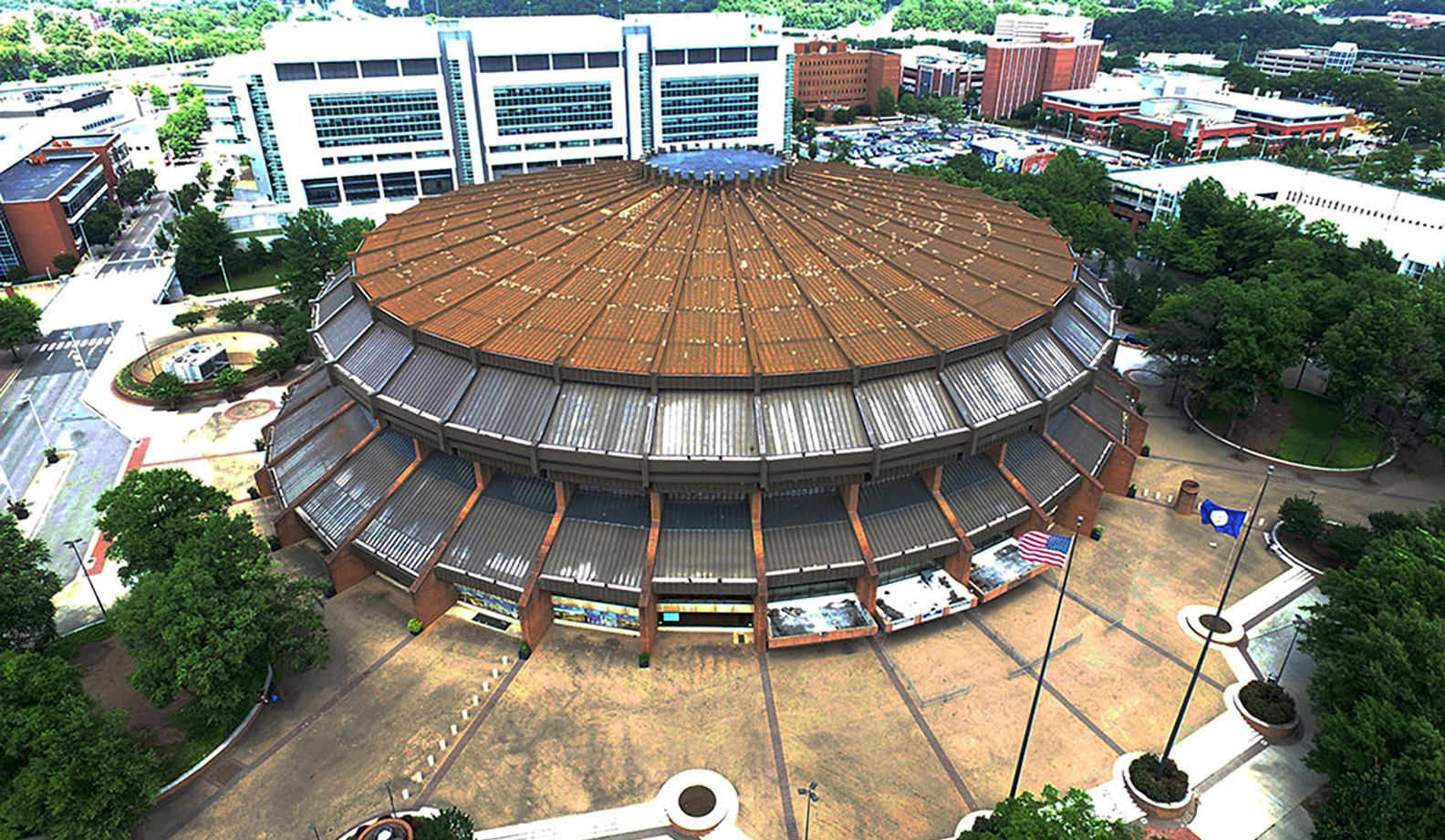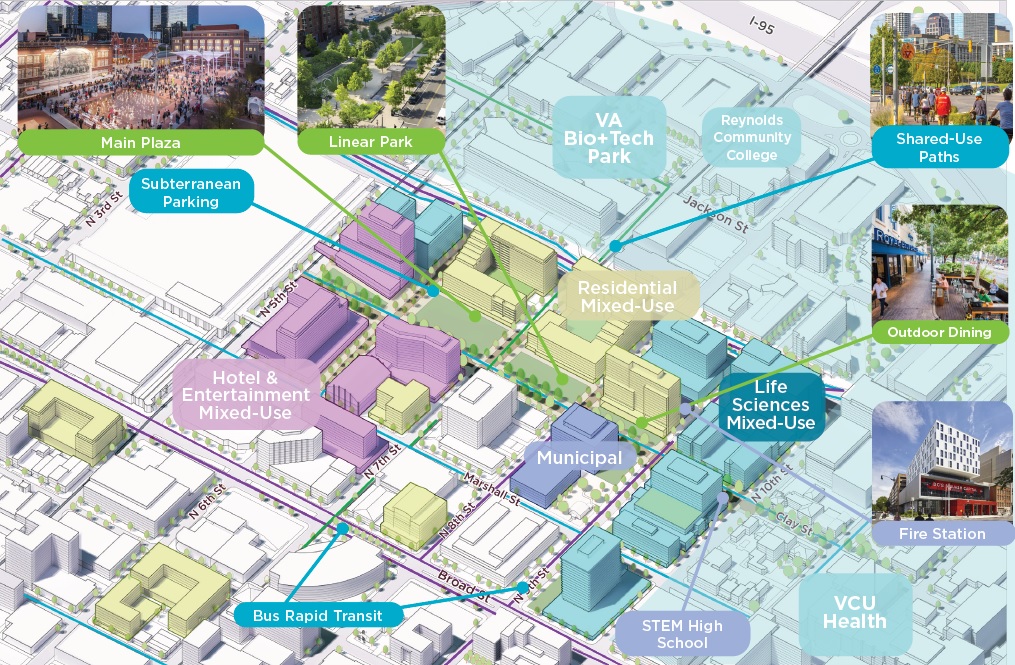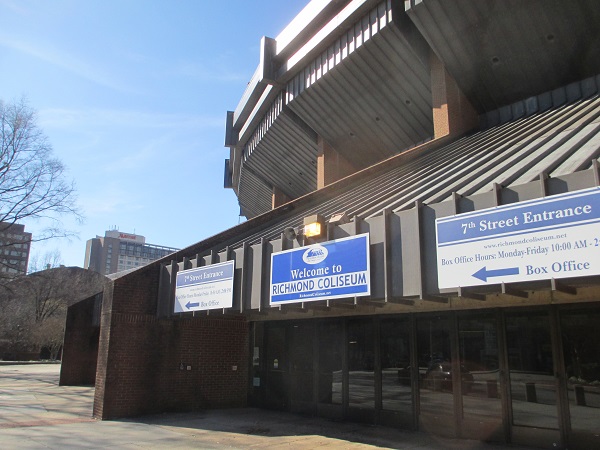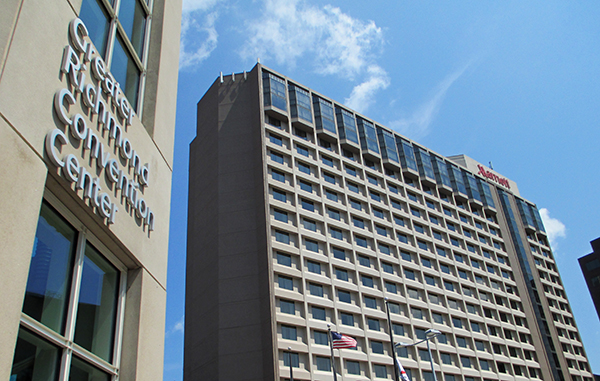
The Richmond Coliseum has quite a storied past but the shuttered arena is slated to be redeveloped. (BizSense file photos)
On the heels of lining up a development team for Richmond’s Diamond District project, city administrators are getting ready to launch a similar process for part of the City Center area that includes the Richmond Coliseum.
Richmond’s Economic Development Authority is preparing a joint solicitation that it plans to issue with the Greater Richmond Convention Center Authority to gauge development interest in a 9-acre assemblage that includes the shuttered arena and the site of a long-sought convention center hotel.
The request for interest (RFI), planned to go out this fall, also would include the neighboring Blues Armory building and adjoining properties that once made up the old Sixth Street Marketplace. Those properties are being included following a recent resolution by the Richmond Redevelopment & Housing Authority to transfer their ownership to the EDA, as the city did in May with the Coliseum.
With the RRHA properties in hand and the GRCCA involved, the EDA is packaging the properties as one whole economic development site, as opposed to issuing separate RFIs for different city-owned parcels that make up the bulk of the 26-acre City Center area. Adding the RRHA properties increases the site that the city is working with from 4 acres to 9 acres, Economic Development Director Leonard Sledge said.
Sledge said the approach provides a greater economic development opportunity to prospective developers that could vie for the site.
“We think we have a great opportunity to move forward with implementing the vision that’s in the City Center small area plan,” Sledge said, referring to the City Center Innovation District Small Area Plan that was adopted in January as an amendment to the Richmond 300 master plan.
With the assemblage, he added, “We now have a much larger, critical mass that can start to anchor redevelopment on those underutilized, publicly owned parcels.”
Involving the GRCCA adds a regional touch to marketing the site, which is made up of some of the properties previously pitched for Richmond’s unsuccessful Navy Hill plan. Where the city was driving that effort on its own, the joint solicitation with the GRCCA brings in the neighboring counties of Chesterfield, Hanover and Henrico, whose chief administrators are among the authority’s membership.
Sledge said the authority’s long-held goal of establishing a convention center hotel warrants its involvement in the City Center solicitation. Tourism officials have long said such a hotel is needed on top of existing lodging options for the convention center to reach its full potential.
“Even predating the small area plan, for years there has been talk about the need for additional hotel keys – a convention or headquarters hotel, per se – and we see collaborating with the Greater Richmond Convention Center Authority as a great way of accomplishing that goal,” Sledge said.
Issuing the RFI jointly, he added, would help “assure that the needs of the city are met in terms of redevelopment for this parcel, but also to help drive more business to our convention center.”
The authority’s side is being led by a hotel taskforce made up of deputy administrators from the represented localities, along with Richmond Region Tourism’s Jack Berry, Venture Richmond’s Lisa Sims, Sledge, and city planner Maritza Pechin, who’s serving as project manager on the Diamond District project. Sledge said Henrico plays the lead role on behalf of the authority.
In an update to the EDA last month, Sledge said the combined site approach is ideal because each of the individual parcels involved are too large for just a convention center hotel or a mixed-use building. He said combining them to create a larger site allows for a larger, more cohesive development.

A conceptual map of the city blocks and properties involved in the city’s City Center plan and their potential uses. (Image courtesy of the City of Richmond)
“We have a mass of real estate with this 9-plus acres to cause a redevelopment project to get what we desire and want,” Sledge told the board. “We think that we will have robust interest based on conversations that we’re having now, teasing the opportunity with prospective developers as we’re talking about the small area plan and other projects in the city. We expect it will be a very solid outcome.”
Sledge said the solicitation would be similar to the RFI issued for the Diamond District, with development teams asked to show their experience with past projects, particularly hotels, as well as community benefits and approaches to the site.
He told the board that the development would likely involve a public-private partnership, as well as some form of tax-increment financing, or TIF, which local governments can use to help pay for a project using tax revenues generated over time.
Sledge said they’re aiming to issue the solicitation early this fall, following a related area-wide rezoning of the 20-block area that makes up City Center. That rezoning, which was presented in April, is scheduled to go to the City Council for a final vote at its Sept. 26 meeting.
Once the solicitation is finalized, Sledge said it will be up to the EDA board to provide final approval before it goes out.
Meanwhile, another portion of the former Navy Hill site is getting prepped for redevelopment.
Capital City Partners, made up of the development team behind Navy Hill, is readying the site of the former Public Safety Building for a scaled-down version of the three-building complex it initially proposed in 2020. The revised development plan remains under city review.
• BizSense reporter Mike Platania contributed to this report.

The Richmond Coliseum has quite a storied past but the shuttered arena is slated to be redeveloped. (BizSense file photos)
On the heels of lining up a development team for Richmond’s Diamond District project, city administrators are getting ready to launch a similar process for part of the City Center area that includes the Richmond Coliseum.
Richmond’s Economic Development Authority is preparing a joint solicitation that it plans to issue with the Greater Richmond Convention Center Authority to gauge development interest in a 9-acre assemblage that includes the shuttered arena and the site of a long-sought convention center hotel.
The request for interest (RFI), planned to go out this fall, also would include the neighboring Blues Armory building and adjoining properties that once made up the old Sixth Street Marketplace. Those properties are being included following a recent resolution by the Richmond Redevelopment & Housing Authority to transfer their ownership to the EDA, as the city did in May with the Coliseum.
With the RRHA properties in hand and the GRCCA involved, the EDA is packaging the properties as one whole economic development site, as opposed to issuing separate RFIs for different city-owned parcels that make up the bulk of the 26-acre City Center area. Adding the RRHA properties increases the site that the city is working with from 4 acres to 9 acres, Economic Development Director Leonard Sledge said.
Sledge said the approach provides a greater economic development opportunity to prospective developers that could vie for the site.
“We think we have a great opportunity to move forward with implementing the vision that’s in the City Center small area plan,” Sledge said, referring to the City Center Innovation District Small Area Plan that was adopted in January as an amendment to the Richmond 300 master plan.
With the assemblage, he added, “We now have a much larger, critical mass that can start to anchor redevelopment on those underutilized, publicly owned parcels.”
Involving the GRCCA adds a regional touch to marketing the site, which is made up of some of the properties previously pitched for Richmond’s unsuccessful Navy Hill plan. Where the city was driving that effort on its own, the joint solicitation with the GRCCA brings in the neighboring counties of Chesterfield, Hanover and Henrico, whose chief administrators are among the authority’s membership.
Sledge said the authority’s long-held goal of establishing a convention center hotel warrants its involvement in the City Center solicitation. Tourism officials have long said such a hotel is needed on top of existing lodging options for the convention center to reach its full potential.
“Even predating the small area plan, for years there has been talk about the need for additional hotel keys – a convention or headquarters hotel, per se – and we see collaborating with the Greater Richmond Convention Center Authority as a great way of accomplishing that goal,” Sledge said.
Issuing the RFI jointly, he added, would help “assure that the needs of the city are met in terms of redevelopment for this parcel, but also to help drive more business to our convention center.”
The authority’s side is being led by a hotel taskforce made up of deputy administrators from the represented localities, along with Richmond Region Tourism’s Jack Berry, Venture Richmond’s Lisa Sims, Sledge, and city planner Maritza Pechin, who’s serving as project manager on the Diamond District project. Sledge said Henrico plays the lead role on behalf of the authority.
In an update to the EDA last month, Sledge said the combined site approach is ideal because each of the individual parcels involved are too large for just a convention center hotel or a mixed-use building. He said combining them to create a larger site allows for a larger, more cohesive development.

A conceptual map of the city blocks and properties involved in the city’s City Center plan and their potential uses. (Image courtesy of the City of Richmond)
“We have a mass of real estate with this 9-plus acres to cause a redevelopment project to get what we desire and want,” Sledge told the board. “We think that we will have robust interest based on conversations that we’re having now, teasing the opportunity with prospective developers as we’re talking about the small area plan and other projects in the city. We expect it will be a very solid outcome.”
Sledge said the solicitation would be similar to the RFI issued for the Diamond District, with development teams asked to show their experience with past projects, particularly hotels, as well as community benefits and approaches to the site.
He told the board that the development would likely involve a public-private partnership, as well as some form of tax-increment financing, or TIF, which local governments can use to help pay for a project using tax revenues generated over time.
Sledge said they’re aiming to issue the solicitation early this fall, following a related area-wide rezoning of the 20-block area that makes up City Center. That rezoning, which was presented in April, is scheduled to go to the City Council for a final vote at its Sept. 26 meeting.
Once the solicitation is finalized, Sledge said it will be up to the EDA board to provide final approval before it goes out.
Meanwhile, another portion of the former Navy Hill site is getting prepped for redevelopment.
Capital City Partners, made up of the development team behind Navy Hill, is readying the site of the former Public Safety Building for a scaled-down version of the three-building complex it initially proposed in 2020. The revised development plan remains under city review.
• BizSense reporter Mike Platania contributed to this report.






The city needs to continue to beef-up its Planning and Permitting department to move these projects forward while it’s also servicing the many proposals it is to receive in Manchester, etc. If the City is serious about its concerns of affordability, the answer is to let the market provide enough supply to balance the demand for it. It must cease to be the bottle-neck. Revenues from applications and increasing assessments are swelling the city coffers. Hire more people and offer higher salaries to lure better applicants. This City is just taking off!
I for one won’t shed a tear for the Richmond Coliseum. I always felt that it was one of the ugliest buildings I’ve ever seen. I’m looking forward to seeing this area developed and transformed into something we can be proud of.
What was it even meant to tie in with? Nothing in that immediate area complements it in either material or design. I can’t remember it ever not being an eyesore.
The City should demolish the Coliseum now and provide the land as it’s part in the redevelopment of the area.The developer(s) can then offer the City a fair price for the improved land and let the buyer do the rest under zoning guidelines. This should be a far different situation than the Diamond District.
I know it’s too late now, but I still wonder why the Hampton Coliseum continues to thrive while the Richmond Coliseum has died.
Same with the Norfolk scope. Both are old ugly run down arenas. Norfolk and the Hampton roads metro seems to have an even harder time getting projects approved than Richmond city does. I feel like they have way more city wide issues down that way than we do. I know there main draw is that navy and is why so many live down that way but that’s all they have and rely on. If the navy were to ever leave that area they would be in very big trouble population wise and in very bad financial shape. I hope they… Read more »
I haven’t been to the Norfolk scope and can’t speak to the bureaucratic challenges, but wanted to point out that the Hampton coliseum is still an asset to that area while we have let the Richmond Coliseum go to waste.
For what it’s worth, Hampton was always a nicer, better building
I saw great concerts at the Richmond Colliseum and thoroughly had no complaints about the building!
Went to several concerts at the Hampton Colliseum (The Rolling Stones)!!!!and loved it as well!!! It is sad that we no longer have an indoor Colliseum to see great bands in Richmond any more with that kind of capacity for fans!!!
Hi Gigi – I, too, saw some great concerts at the Coliseum, but with an asterisk. Due to the design, the sound was consistently horrible. Access to seats was a mess, especially if you had mobility issues. For larger touring acts (Circus, big concerts, etc) the logistics of staging were a nightmare. No place to stage trucks, etc. The amenities for artists were non-existent. One of the last major events there was a cheerleaders competition and the girls were doing their hair along the concourse because the electric didn’t work in the old locker rooms. Said concourse was horrible if… Read more »
Dumb. The city should subdivide this land and auction to the highest bidder. This would give the city immediate cash in hand, allow the city to immediately begin collecting property tax, avoid the need to have any sort of special tax arrangement whereby the developer gets the tax revenue and not the city, and by allowing more medium sized developers to bid, instead of one or two giant insiders, the city would get the best possible price for the property. Instead, this will be Navy Hill all over again: a deal structured to be so big only one or two… Read more »